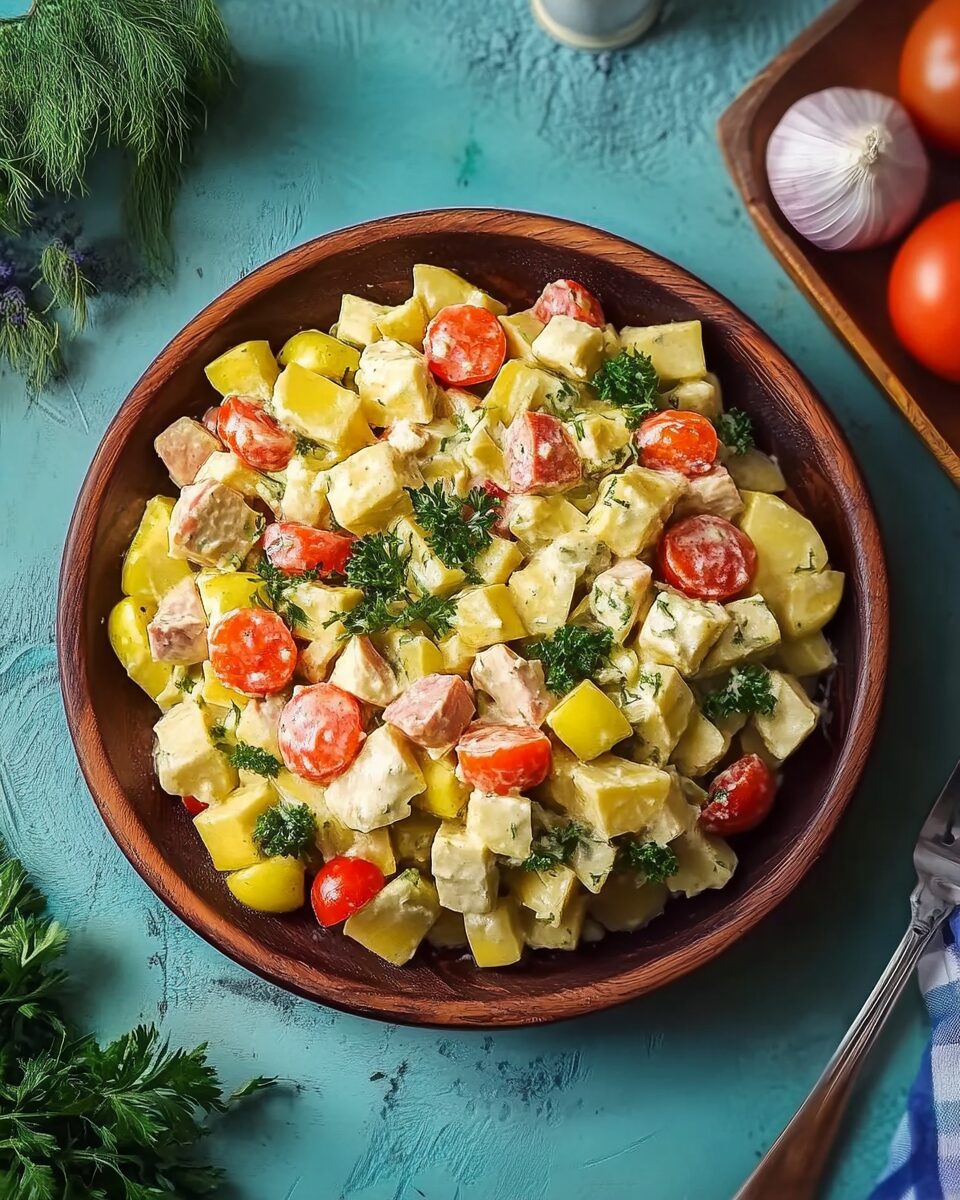Russian Salad Olivye, or Olivier Salad, is a beloved dish known for its creamy texture and satisfying flavors. It’s a perfect balance of tender potatoes, boiled eggs, sweet peas, and tangy pickles, all brought together by a rich mayonnaise dressing. Often served chilled, it’s a popular side dish or appetizer at family gatherings and festive occasions.
What makes this salad so special is its versatility and the layers of flavors that develop as it chills. The crispness of the pickles contrasts beautifully with the softness of the potatoes and eggs, while the peas and carrots add a gentle sweetness to every bite. Whether you’re celebrating a holiday or simply craving a comforting salad, this dish is sure to become a favorite.
Full Recipe:
-
4 medium potatoes, peeled and diced
-
3 large eggs, boiled and chopped
-
1/2 cup frozen peas, thawed
-
1/2 cup carrots, diced and boiled
-
1/2 cup cooked chicken breast, diced (optional for a traditional twist)
-
1/2 cup pickles, finely chopped
-
1/2 cup mayonnaise
-
Salt and pepper to taste
-
1 tablespoon Dijon mustard (optional)
Directions:
-
In a large pot, boil the potatoes and carrots until tender. Drain and set aside to cool.
-
Boil the eggs in a separate pot for about 10 minutes. Let them cool before peeling and chopping them into small pieces.
-
In a large bowl, combine the boiled potatoes, carrots, eggs, peas, pickles, and chicken (if using).
-
Add the mayonnaise and Dijon mustard (if using), mixing everything thoroughly to coat.
-
Season with salt and pepper to taste.
-
Chill the salad for at least an hour before serving.
Prep Time: 20 minutes | Cooking Time: 15 minutes | Total Time: 35 minutes
Kcal: 320 kcal | Servings: 4 servings
Authentic Russian Salad Olivye: A Classic Dish with Rich History and Flavor
Russian Salad Olivye, also known as Olivier Salad, is a beloved dish that has been a staple of Russian cuisine for centuries. This creamy, hearty salad is a combination of simple, yet flavorful ingredients, and its popularity extends far beyond Russia, finding its way into the kitchens of many Eastern European countries and beyond. Often served as a side dish, a cold appetizer, or even a main course, it is a dish that has been passed down through generations, with each version carrying its own regional touch.
The History of Russian Salad Olivye
The roots of Russian Salad Olivye date back to the late 19th century, when it was first created by Lucien Olivier, a French chef working in Moscow. Olivier was the head chef of the renowned Hermitage restaurant, where he developed a unique salad that quickly became famous among the city’s elite. The original version of this dish was quite different from the one we know today, containing luxurious ingredients like lobster, grouse, and caviar, all dressed in a homemade French dressing.
However, after the chef’s departure and the closure of the Hermitage, the recipe underwent several modifications. Over time, the dish became simpler and more affordable, with ingredients like chicken, boiled potatoes, eggs, and peas taking the place of the original high-end components. By the Soviet era, Russian Salad Olivye had evolved into the version that is now known across Eastern Europe and the former Soviet states. It became a symbol of Soviet cuisine and was commonly served during holidays, celebrations, and family gatherings.
Cultural Significance of Russian Salad Olivye
In Russia and many other Eastern European countries, Russian Salad Olivye is more than just a dish; it is an integral part of cultural celebrations and family traditions. It is particularly popular during New Year’s Eve and other festive occasions, where it is often found at the center of the dinner table. The salad has earned its place as a comfort food, one that brings back nostalgic memories for many who grew up with it during the Soviet era.
Its versatility is one of the key reasons why Russian Salad Olivye remains a timeless favorite. The dish can be made in advance, chilled, and served cold, making it a convenient option for large gatherings or busy weeknights. Its creamy texture, combined with the subtle crunch of pickles and the sweetness of peas, makes it a satisfying dish that appeals to both children and adults alike.
Modern Variations of Russian Salad Olivye
While the classic recipe for Russian Salad Olivye has remained relatively unchanged, there are numerous variations of the dish that have emerged over time. Different regions and cultures have put their own spin on this traditional salad, adapting it to local tastes and available ingredients.
One common variation involves the use of chicken or turkey as the main protein instead of the original beef or grouse. In some regions, ham is used, while others may opt for a more vegetarian-friendly version, omitting the meat altogether. Additionally, some recipes include ingredients like apples or radishes to add extra crunch or a touch of sweetness to the salad.
The type of mayonnaise used can also vary, with some opting for homemade mayonnaise, while others use store-bought options. The dressing itself plays a pivotal role in the flavor profile of the salad, with some adding mustard or sour cream for an extra layer of tanginess. However, the core components—potatoes, eggs, peas, and pickles—remain constant in most versions of the dish.
Serving Tips for Russian Salad Olivye
Serving Russian Salad Olivye can be as simple or as elegant as you wish. Traditionally, the salad is served cold in a large bowl or on a platter, where guests can help themselves. For more formal occasions, the salad can be molded into individual portions or served in an elegant glass bowl to enhance its presentation.
To make the dish more visually appealing, garnishing with fresh herbs such as parsley or dill is a great option. Some even opt for a sprinkle of paprika or a few extra pickles on top for added flavor and color. When served alongside other traditional dishes like beetroot salad, pickled vegetables, and hearty meat dishes, Russian Salad Olivye can complement any festive meal with its creamy richness and satisfying texture.
For those looking to take their presentation to the next level, consider creating individual portions in small cups or bowls. This is an especially great option for parties, where guests can enjoy their own serving of salad without needing to use serving spoons.
Why Russian Salad Olivye is Loved by Many
The enduring popularity of Russian Salad Olivye can be attributed to several factors. First and foremost, it is incredibly easy to prepare, making it a go-to dish for both novice and experienced cooks. With just a few basic ingredients and minimal cooking, the salad can be put together in no time, making it perfect for busy weeknights or last-minute gatherings.
Another reason for its popularity is its versatility. While the traditional version is beloved by many, the salad can be easily customized to suit different tastes and dietary preferences. Whether you prefer a vegetarian version, a meat-based version, or a version with added spices, there is no wrong way to make Russian Salad Olivye.
Furthermore, the creamy texture and combination of flavors make it a comforting and satisfying dish. It is a great way to incorporate vegetables into your diet in a fun and flavorful way. The potatoes, peas, and pickles add both texture and taste, while the mayonnaise provides a creamy and rich backdrop for all the ingredients.
The Health Benefits of Russian Salad Olivye
While Russian Salad Olivye is often considered a comfort food, it also provides several health benefits. The potatoes used in the salad are a good source of vitamins and minerals, including vitamin C, potassium, and fiber. The eggs add a healthy dose of protein, while the peas provide additional fiber and antioxidants.
Additionally, the pickles in the salad offer a probiotic boost, supporting gut health and digestion. However, it’s important to note that the salad is often dressed with mayonnaise, which can be high in calories and fat. For a healthier version, you can substitute the mayonnaise with a lighter alternative, such as Greek yogurt or a reduced-fat mayo.
Conclusion: The Timeless Appeal of Russian Salad Olivye
Russian Salad Olivye is a dish that has stood the test of time, loved by generations for its creamy texture, comforting flavors, and rich cultural history. Whether you’re preparing it for a family meal or a festive occasion, this salad remains a versatile and crowd-pleasing option that will never go out of style. With its roots in Russian cuisine, yet enjoyed worldwide, it is a dish that brings people together and sparks fond memories of celebrations and traditions.
No matter how you choose to prepare it, Russian Salad Olivye continues to be a dish that symbolizes the warmth and joy of shared meals and family gatherings. Its simple ingredients and rich flavor profile make it a timeless classic, cherished by home cooks and food enthusiasts alike. So the next time you are looking for a dish that is both comforting and delicious, look no further than Russian Salad Olivye—it’s a dish that never disappoints.






